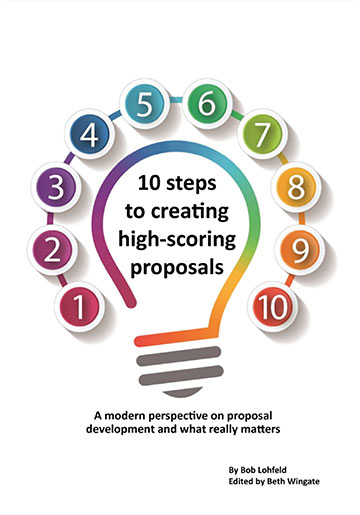How to Survive and Thrive Under FAR Part 10 Changes

ABSTRACT: This is a series of articles on the impact of Revolutionary Federal Acquisition Regulation (FAR) Overhaul (RFO) changes on government contractor (GovCon) business development, capture, and proposal programs. This article focuses on changes to FAR Part 10 – Market Research and identifies the opportunities and risks that industry growth teams face as a result of FAR 2.0 acquisition policy changes.
Introduction
On May 6, 2025, the Office of Management and Budget (OMB) launched Revolutionary Federal Acquisition Regulation (FAR) Overhaul (RFO) Phase 1 of “FAR 2.0,” with the stated intent of cutting red tape and making it easier for agencies to buy cutting-edge solutions1. The changes proposed for FAR 2.0 are implemented as FAR deviation guidance, with formal change approvals planned for late FY25 and beyond.
FAR 2.0 is advertised as promoting speed and reduced cost by moving non-statutory requirements for acquisition of capabilities away from a FAR-based central prescription to delegated agency judgment. Under FAR 2.0, the FAR retains only requirements mandated by statute; other content may be deleted or relocated to nonbinding federal “buyer guides” or other vehicles. By converting mandatory clauses into advice in a buyer guide, the FAR Council seeks to demonstrate that innovation will thrive when standards are set closer to the mission. OMB memo M2526 Overhauling the Federal Acquisition Regulation underscores this intent, urging agencies to take ownership of their acquisition frameworks rather than wait for government-wide updates.
These changes have the potential to dramatically impact GovCon business development, especially pre-solicitation customer engagement and capture. Industry can expect to see increased need (and, hopefully, commensurate opportunity) to provide acquiring agencies with recommendations on how best to acquire capabilities and systems. This, in turn, demands that industry place greater emphasis on understanding and building rapport with those acquiring agencies.
For preparing proposals, industry needs to respond to this philosophical change in approach by viewing solicitations through the following lens:
- Assume anything that appears in Sections L, M, or the clause block is mandatory;
- If the RFP elsewhere references a playbook, buyer guide, or similar non-binding guidance, compare the benefit of following it against cost and schedule, and document the rationale; and
- Consider modifying your compliance/traceability matrix to distinguish mandatory items from guidance.
This article describes the RFO’s changes to FAR Part 10 – Market Research and summarizes the opportunities and challenges these changes present to GovCon companies.
From FAR to FAR 2.0: A Quick Refresher
In the mid-1990s, FAR Part 10—Market Research was added to the FAR, to shift federal procurement policy toward buying commercially available solutions wherever possible, and thereby reduce acquisition lead times and improve cost-efficiency. The statutory basis for this objective is the Competition in Contracting Act, 41 U.S.C. § § 1703, 3306, and 3307, and 10 U.S.C. § 3453. To achieve this, FAR Part 10 mandated market research as a first step in the acquisition lifecycle, to ensure that agencies understand the commercial marketplace before developing requirements or issuing solicitations. The original FAR Part 10 also aimed to:
- Support efforts to streamline requirements development. The goal was to compel acquiring agencies to state their needs in terms of the problem to be solved or the performance required, rather than by dictating design. In theory, this would enable the procurement of commercial products and services faster and at a lower cost than custom solutions. The FAR implemented an “order of precedence” favoring commercial or non-government standards over military/Federal standards when possible.
- Promoting Competition and Broadening Participation. The statutory mandate for acquiring agencies to conduct market research was viewed as a means to ensure a competitive environment by identifying multiple potential sources and preventing situations where an agency might inadvertently sole-source due to a lack of market awareness. The FAR Part 10 regulation required acquiring agencies to actively survey the market for all sources. The expectation was that more companies—including non-traditional government contractors and small businesses—would have the opportunity to compete for contracts.
- Improving Procurement Efficiency. When FAR Part 10 was implemented, Congress explicitly noted that purchasing existing products could save money and decrease acquisition time. Market research was also regarded as a tool to minimize false starts and mid-stream corrections that occur due to incomplete or inaccurate market understanding.
The RFO revisions to FAR Part 10 can be broadly characterized as reinforcing the original intent of spurring efficiencies by procuring commercial products and services. The RFO change shifts responsibility to the acquiring agencies for deciding how to conduct market research and how to determine whether to acquire commercial products.
It is worth noting that the revised FAR Part 10 retains the regulatory requirements derived from the Competition in Contracting Act (CICA) of 1984 and other statutes, consistent with the overall FAR 2.0 approach. Content removed from the original FAR Part 10 may be made available through advisory documents, such as a buyer guide; the actual content of such a buyer guide has yet to be determined.
The Shift in FAR Part 10 Approach
The RFO changes to FAR Part 10 are consistent with the dual objectives of (1) promoting the acquisition of commercial products and services and (2) moving away from central prescription toward delegated acquiring agency judgment. Table 1 summarizes the most impactful changes resulting from the FAR Part 10 revision.
Table 1. FAR Part 10 Changes and Impacts You Need to Know
| Change Title and Reference | Description of Change | Significance and Impact |
| New 5-step order of priority for satisfying requirements § 10.001 (f)2 | Introduces explicit priority hierarchy that starts with “commercial products/services on an existing GWAC” and ends with “nondevelopmental items.” No such priority-based category scheme existed in original FAR Part 10. | Acquiring agencies must perform market surveys for the sole purpose of correctly placing industry products and services in the prioritized categories. Industry must be prepared to prove that their capabilities meet the FAR 2.101 definitions of commercial or nondevelopmental3. Creates a significant advantage for GWAC holders. |
| “Must” use commercial products/services to the maximum extent practicable § 10.001 (f) | Replaces earlier advisory language with a prescriptive mandate tied to the new priority categories. | Acquiring agencies will face higher barriers to using non-commercial products and services. |
| Mandatory limit on information requests § 10.001 (d) | Directs “When conducting market research, agencies must not ask potential sources to submit more than the minimum information necessary to make the determinations required in paragraph (f).” | Expect market surveys to be sharply focused on proving commercial product and service alignment to priority categories. Responses will be shorter, with less opportunity for offering advice on acquisition strategy and evaluation criteria. |
| Removes original FAR § 10.002 (b)(1) ability to request product and service information other than that relevant to the prioritized categories (e.g., warranty, buyer financing, availability, energy efficiency). | Directive nature of revision effectively prohibits using RFIs to solicit value-added information that does not bear directly on priority category determination. | |
| Removes original FAR § 10.002 (b)(2) recommendations for market survey techniques. | Removed content may be made available in a Practitioners Album, buyer guide, or other supporting documentation— this is yet to be determined. Acquiring agencies select technique that best suits the application. | |
| Fair-competition / procurement-integrity reminder § 10.001 (c) | Adds FAR Part 1 language “Agencies should engage in responsible and constructive exchanges with industry… to gather information…” | Continue to encourage diversity of methods and strategies to gather market research information. |
| Adds reference to FAR § 3.104 Procurement Integrity. | Reinforces importance of Procurement Integrity in market research activities. | |
| Deletion of market research applications for consolidation, bundling, disaster relief, other triggers from original § 10.001 (3)(v – ix) | Deletes clauses that apply market research results to other FAR Parts. Applies to requirements found in other FAR parts as well (e.g., cybersecurity). | Market research sharply focuses on assignment to priority category. Requirements for other FAR parts previously supported are likely to be addressed in solicitations as compliance for proposals. |
| Removal of small-business specialist & SBA PCR consultation requirement § 10.001 (c) | Removes requirement to notify incumbent small business when acquiring agency intends to bundle or consolidate. | Small-businesses need to plan on increasing reliance on Part 7 reviews for Small Business Consideration and monitor RFO changes to FAR Part 7 – Acquisition Planning. Small firms should proactively engage with the acquiring agency Office of Small and Disadvantaged Business Utilization rather than relying on indicators in market research. |
The most notable change in FAR Part 10 is the invention of a prioritized categorization that promotes commercial/nondevelopmental product and service acquisition. Market research now becomes the Federal Government’s tool for both identifying and ruling out commercial approaches versus custom development. It’s worth noting that the FAR Part 10 revision effectively prohibits using market research for any purpose other than establishing the availability of products and services within the prioritized categories.
All other FAR Part 10 changes essentially remove content that is not grounded in statute or can be referenced in other FAR sections. The government has activated a Practitioners Album, which may serve as a repository for content removed from the FAR due to RFO changes. The Practitioners Album, buyer guides, and other reference documents will provide government acquisition professionals with advisory materials on explanations, tools, and best practices.
What RFO Changes to Part 10 Mean for Industry
Build a commercial product portfolio from which you can sell to the government. The RFO changes to FAR Part 10 are an early indicator of the government’s intent to buy commercially whenever possible. The changes not only prioritize buying from commercial sources but, in this author’s opinion, also erect barriers to buying from non-commercial sources. Therefore, make sure your growth professionals are familiar with FAR Part 12 – Acquisition of Commercial Products and Commercial Services.
Key Takeaway
RFO changes to FAR Part 10 mean that market research is no longer an exploratory or shaping tool—it’s now a gatekeeping mechanism to enforce a new acquisition priority hierarchy. It’s essential that industry take this into account in pre-solicitation solution development.
Energize your business development team to ensure customers know all about your commercial products and services outside the market research process. The market research process is now focused exclusively on identifying commercial/nondevelopmental products and services. Consider engaging with customers outside the market research process to show prospective customers other attributes that bear directly on the likelihood of mission and contract success. Simply qualifying your product may not be enough to close the sale, as competitors’ products may also meet the qualification criteria.
Act on the idea of customers being able to buy your commercial products and services through a Government-Wide Acquisition Contract (GWAC). The top priority category for market research is identifying commercial sources that can be accessed through a GWAC. You need to energize your business development cadre, and perhaps your corporate development office, to partner with existing GWAC teams as well as compete for future access. Confirm that your value proposition and offerings for a prospective GWAC prime are clear and consistent.
Key Takeaway
If the government cannot access your commercial products and services through a GWAC, then you will be at a competitive disadvantage. In such a case, you should consider strategic teaming to avoid losing ground to competitors who offer similar commercial products and services and are also accessible through a GWAC.
If you are a small business, build rapport with the customer’s Office of Small and Disadvantaged Business Utilization (OSDBU) and with leadership in the customer’s program office. The RFO’s effort to streamline and simplify FAR Part 10 eliminates the requirement for the government to notify incumbent small businesses of its intent to bundle or consolidate requirements. It may be unwise to rely solely on FAR Part 7 – Acquisition Planning as the basis for your interactions with the customer.
Key Takeaway
Small businesses need to make proactive engagement with OSDBU and agency program offices an essential part of their business development program.
Conclusions
The RFO changes to FAR Part 10 reflect the government’s clear intent to buy more from commercial sources, thereby reducing costs and the time to acquire needed capabilities. Specifically, FAR Part 10 now has an overarching acquisition prioritization scheme and mandates that market survey activity be limited to soliciting only the information needed to place products and services in that scheme. The use of market research for other purposes is prohibited. These features are new to FAR Part 10.
The remaining changes to FAR Part 10 serve the stated RFO objective of removing all content whose foundation does not lie in statutes or is redundant/extraneous. The removed content will be deleted or shifted to a future buyer guide or other reference platform, which has not yet been determined.
By Bruce Feldman and Jacob Bertram
Bruce Feldman, Vice President, Lohfeld Consulting Group. Bruce brings more than 30 years of experience as a subject matter expert (SME) in business development, capture management, and proposal development specializing in Space and National Intelligence programs for the U.S. Air Force (USAF), U.S. Space Force (USSF), Intelligence Community (IC), Office of the Secretary of Defense (OSD), Department of Defense (DOD) 4th Estate, and Combatant Commands. He leads Lohfeld Consulting Group’s Artificial Intelligence (AI) initiatives and is the lead trainer for our Generative AI for Proposal Professionals classes, a trainer for our Capture Management and Strength-Based Winning® classes, as well as a consulting advisor.
Jacob Bertram is a senior leader in the federal procurement industry with over 20 years of experience spanning GSA, the Department of Energy, DCMA, and DCAA. He currently advises Fortune 500 companies, government agencies, and federal contractors on acquisition strategy, pricing, audit readiness, and operational efficiency. Jacob is DAWIA Level III certified in Contracting and a member of the Defense Acquisition Corps.
Lohfeld Consulting Group has proven results specializing in helping companies create winning captures and proposals. As the premier capture and proposal services consulting firm focused exclusively on government markets, we provide expert assistance to government contractors in Capture Planning and Strategy, Proposal Management and Writing, Capture and Proposal Process and Infrastructure, and Training. In the last 3 years, we’ve supported over 550 proposals winning more than $170B for our clients—including the Top 10 government contractors. Lohfeld Consulting Group is your “go-to” capture and proposal source! Start winning by contacting us at www.lohfeldconsulting.com and join us on LinkedIn, Facebook, and YouTube(TM).
Paperback or Kindle
10 steps to creating high-scoring proposals
by Bob Lohfeld
contributors Edited by Beth Wingate
Subscribe to our free ebrief
Teaming friends, frenemies, and enemies—12 tips to mitigate harmful effects
Did you know that contracting officers spend up to 20% of their time mitigating disputes between teaming partners? In an informal poll we conducted on LinkedIn last month, 40% of respondents classified their teaming partners as “frenemies” on their last bid.
Explore Further
- Advice (539)
- AI (28)
- APMP (18)
- Army MAPS Contracts (3)
- Business Development (294)
- Capture Management (266)
- Complex Technology Grants Services (26)
- Favorite Books (5)
- GenAI (4)
- Go-to-Market (27)
- Graphics (5)
- Lohfeld Books (2)
- NASA SEWP VI Contracts (2)
- Navy SeaPort-NxG Contracts (2)
- NIST MSE Grants (1)
- NIST NAPMP Grants (2)
- Past Performance (63)
- Post-submission Phase (14)
- Pre-RFP Preparation (264)
- Proposal Management (339)
- Proposal Production (75)
- Proposal Reviews (38)
- Proposal Writing (107)
- Pursuit Phase (108)
- Research Report (4)
- Resources (63)
- Tools & Tips (421)
- Training (13)
- Uncategorized (223)

Sign Up for INSIGHTS and Download your FREE book
We'd love to help you with your proposals. Enjoy our complimentary Lohfeld Consulting Group Capture & Proposal Insights & Tips book with your FREE subscription to our Insights Newsletter.
GET YOUR FREE BOOK



